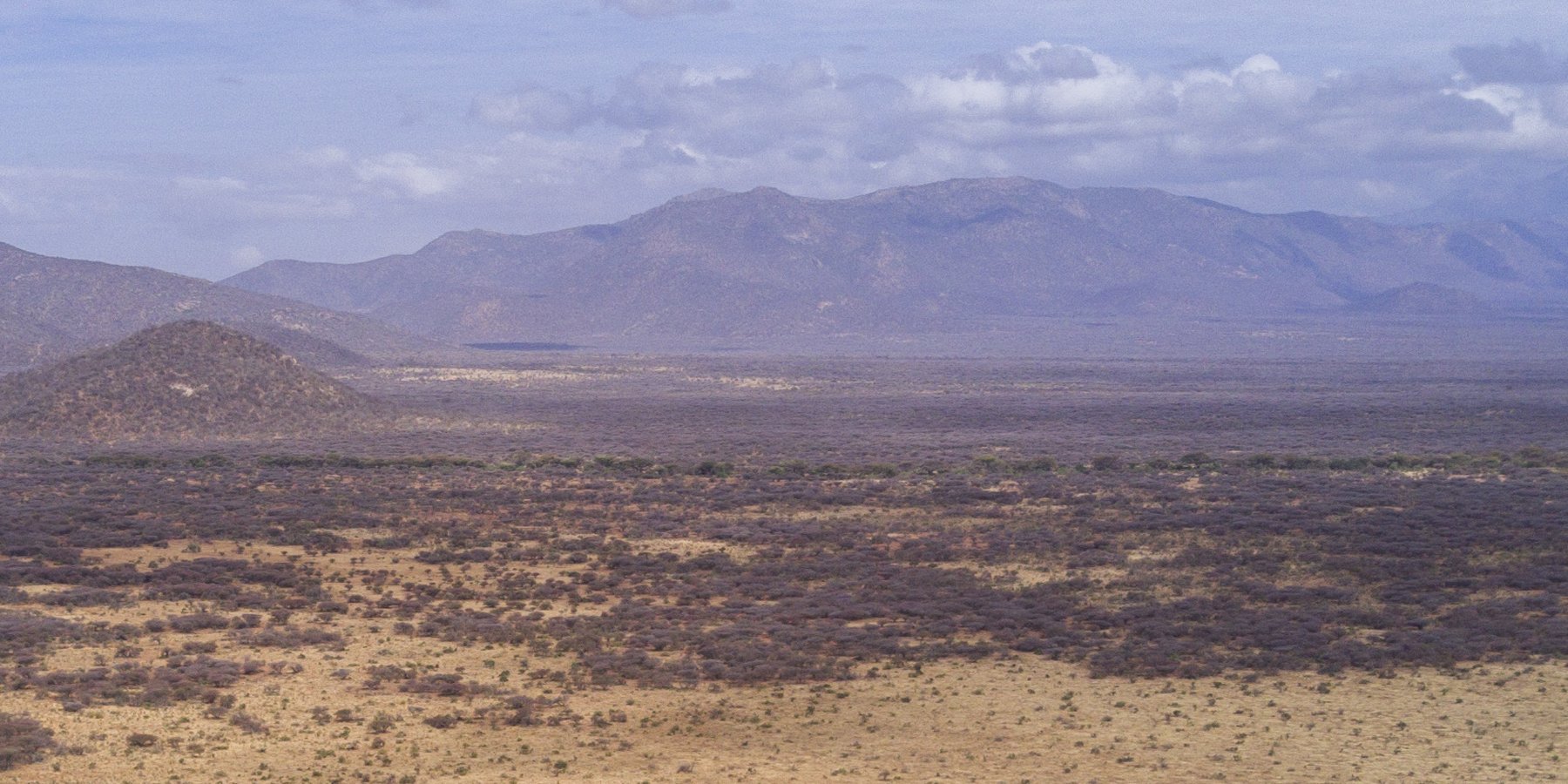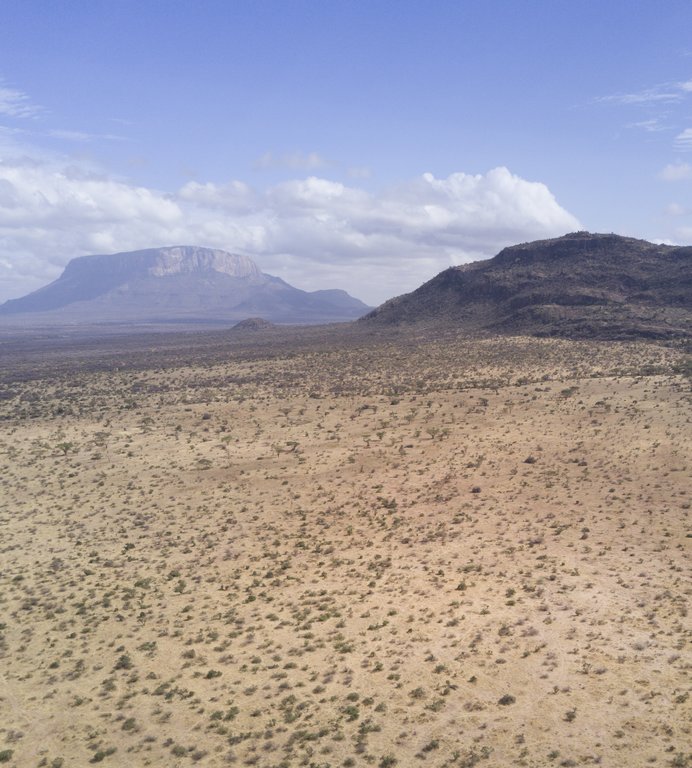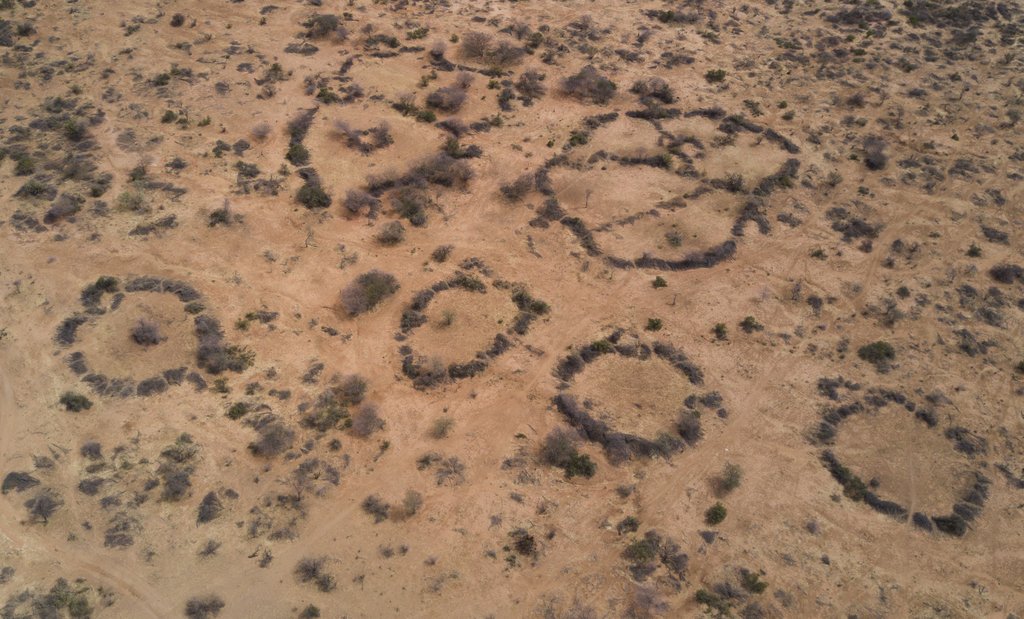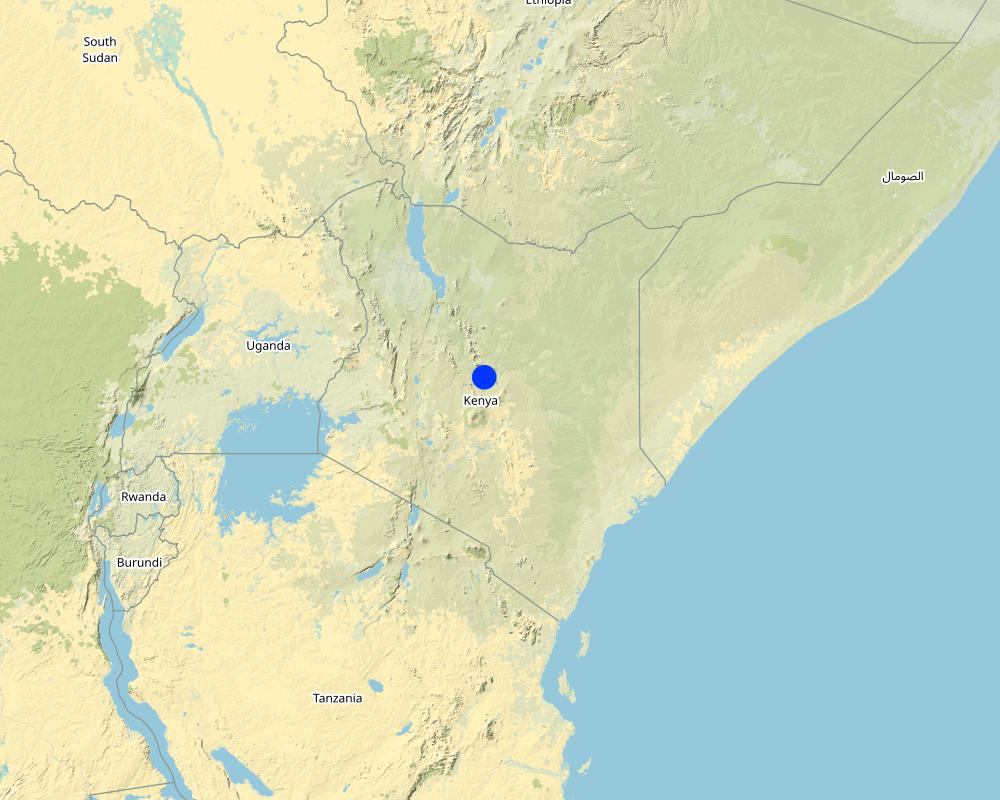Holistic Rangeland Management combined with high end tourism [เคนยา]
- ผู้สร้างสรรค์:
- การอัพเดท:
- ผู้รวบรวม: Harry Wells
- ผู้เรียบเรียง: –
- ผู้ตรวจสอบ: Donia Mühlematter, Rima Mekdaschi Studer, Simone Verzandvoort, Hanspeter Liniger, Joana Eichenberger
"Ramat engop"
approaches_3399 - เคนยา
- บทสรุปทั้งหมดในรูปแบบของ PDF
- บทสรุปทั้งหมดในรูปแบบของ PDF เพื่อพิมพ์
- บทสรุปทั้งหมดในรูปหน้าเว็บ
- บทสรุปทั้งหมด (ไม่มีการจัดเรียง)
- Holistic Rangeland Management combined with high end tourism: 2 พฤศจิกายน 2021 (public)
- Holistic Rangeland Management combined with high end tourism: 10 สิงหาคม 2018 (inactive)
- Holistic Rangeland Management combined with high end tourism: 22 ตุลาคม 2018 (inactive)
- Holistic Rangeland Management combined with high end tourism: 3 กันยายน 2018 (inactive)
- Holistic Rangeland Management combined with high end tourism: 6 พฤษภาคม 2018 (inactive)
ดูส่วนย่อย
ขยายทั้งหมด ย่อทั้งหมด1. ข้อมูลทั่วไป
1.2 รายละเอียดที่ติดต่อได้ของผู้รวบรวมและองค์กรที่เกี่ยวข้องในการประเมินและการจัดเตรียมทำเอกสารของแนวทาง
วิทยากรหลัก
ผู้ใช้ที่ดิน:
ชื่อของโครงการซึ่งอำนวยความสะดวกในการทำเอกสารหรือการประเมินแนวทาง (ถ้าเกี่ยวข้อง)
Book project: Guidelines to Rangeland Management in Sub-Saharan Africa (Rangeland Management)1.3 เงื่อนไขที่เกี่ยวข้องกับการใช้ข้อมูลที่ได้บันทึกไว้ผ่านทาง WOCAT
วันที่เก็บรวบรวมข้อมูล (ภาคสนาม):
11/02/2018
ผู้รวบรวมและวิทยากรหลักยอมรับเงื่อนไขเกี่ยวกับการใช้ข้อมูลที่ถูกบันทึกผ่านทาง WOCAT:
ใช่
2. คำอธิบายของแนวทาง SLM
2.1 การอธิบายแบบสั้น ๆ ของแนวทาง
The establishment of a community wildlife conservancy facilitates (1) 'holistic rangeland management' refering to a to the implementation of a suite of management practices aimed at sustaining and/or improving rangeland productivity such as 'bunched grazing' (livestock concentrated for short duration intensive grazing), short-term 'bomas' (livestock corrals occupied for ~7 days), clearing invasive species and reseeding with grass to assist land rehabilitation/restoration; and (2) High end tourism and monetary donations facilitated by the Northern Rangelands Trust provide funding for the implementation of improved grazing practices and additional income for the community and the reduction of livestock grazing pressure.
2.2 การอธิบายอย่างละเอียดของแนวทาง
การอธิบายอย่างละเอียดของแนวทาง:
Kalama Community Wildlife Conservancy has been established with a hierarchical structure led by a board of 13 members (5 female, 8 male), one representing each of the 13 'zones' of the Conservancy. There are also three subcommittees for grazing, finances and tourism. The main aims are to improve the involvement of the community members in the overall management of the conservancy, the generation of additional income from high end tourism and wildlife conservation and the investment into improved land management. The main sources of funding are revenue from contracted high end tourism operation and donations (facilitated by Northern Rangelands Trust). The approximate breakdown of the funding sources is: Tourism including selling of handicrafts (60%), Donors (25%), County Government (5%), Livestock Trading (5%), Camping (5%). Improved livelihood and ownership in the management as well as shared responsibility and benefits are key incentives for the community members.
Within the conservancy an attractive site on a hill overlooking the plains has been leased to an investor for the establishment of an exclusive tourist lodge on the principle of “invest, operate and transfer”, where the investor builds the infrastructure operates is for an agreed period and then transfers it to the community. Further several comping grounds are available for lower budget tourists. The conservancy profits from the neighbouring Samburu Game Reserves. This provides regular income from the lease of the land the entrance fees into the conservancy, employment opportunities for conservancy members (for catering, kitchen, house cleaning, rangers providing security for tourists and protection for wildlife as well as guides for safaris and for entertainment) and a market for selling handicrafts and souvenirs. Another cornerstone is their relationships with two trusts (Northern Rangeland Trust and the Grevy’s Zebra Trust). They have been supportive in the implementation of several holistic rangeland management practices, which include 'bunched grazing' (livestock concentrated for short duration intensive grazing), short-term 'bomas' (livestock corrals occupied for ~7 days), clearing invasive species and reseeding with grass to assist land rehabilitation/restoration. The main aims are to maintain and/or improve rangeland productivity. Regarding methods, 'bunched grazing' is implemented by a team of herders ensuring the livestock are in a tight herd. Short-term 'bomas' are established on bare ground in the traditional manor (i.e. laying cut thorny woody vegetation on the ground to encircle livestock and help protect them from depredation during the night). Invasive woody vegetation can be used to erect these 'bomas'. Invasive species (predominantly Acacia reficiens) is cleared by hand using machetes during the dry season; branches cut ~1 m above the ground to prevent regrowth. Cut branches are laid on the bare ground beneath and seeds of Cenchrus ciliaris hand-broadcasted prior to the onset of rains. Members of the Kalama Community Wildlife Conservancy carry out these activities, both paid (clearing invasive species and reseeding) and unpaid ('bunched grazing' and short-term 'bomas'). Land users and tourists enjoy and value the benefits of increased forage availability in areas successfully rehabilitated but are dissatisfied with the limited extent of the rangeland improvement.
2.3 รูปภาพของแนวทาง
2.5 ประเทศ ภูมิภาค หรือสถานที่ตั้งที่ได้นำแนวทางไปใช้
ประเทศ:
เคนยา
ภูมิภาค/รัฐ/จังหวัด: :
Samburu County
ข้อมูลเฉพาะเพิ่มเติมของสถานที่ตั้ง:
North of Archers Post Bordering Samburu Game Reserve
Map
×2.6 วันที่เริ่มต้นและสิ้นสุดของแนวทาง
ระบุปีที่เริ่ม:
2006
ถ้าไม่รู้ปีที่แน่นอนให้ประมาณวันที่ที่ริเริ่มใช้แนวทางนี้ :
10-50 ปี
2.7 ประเภทของแนวทาง
- ใช้โครงงานหรือแผนงานเป็นฐาน
2.8 เป้าหมายหรือวัตถุประสงค์หลักของแนวทาง
The main objectives of the approach are to maintain and/or improve rangeland productivity.
2.9 เงื่อนไขที่เอื้ออำนวยหรือเป็นอุปสรรคต่อการนำเทคโนโลยีภายใต้แนวทางนี้ไปปฏิบัติใช้
บรรทัดฐานและค่านิยมทางสังคม วัฒนธรรม ศาสนา
- เอื้ออำนวย
Established traditional practice of erecting 'bomas', particularly using less valuable woody vegetation, facilitates implementation of short-term 'bomas' that only require a change in duration of occupancy.
- เป็นอุปสรรค
Traditional practices of herding one's own immediate family's livestock in separate herds deters land users from agreeing to combine herds into larger groups for 'bunched grazing' (also due to associated issues of disease transmission). Furthermore, lack of observation and enforcement of local grazing rules prevents necessary resting of grazing land.
การมีไว้ให้หรือการเข้าถึงแหล่งการเงินและบริการ
- เอื้ออำนวย
Supplementary income can lead to investment in activities unrelated to livestock husbandry (e.g. setting up small businesses or educating children) rather than increasing heard size, which may prevent further increases in pressure on the rangeland.
- เป็นอุปสรรค
Supplementary income often leads to the purchasing of more livestock, which further increases pressure on the rangeland.
การร่วมมือหรือการทำงานประสานกันของผู้ลงมือปฏิบัติ
- เอื้ออำนวย
Clearing of invasive species and reseeding with grass undertaken by land users from all villages/zones of the Kalama Community Wildlife Conservancy.
- เป็นอุปสรรค
Individual concerns are at odds with that of the wider community, leading to opportunistic breaking of grazing rules and deterioration of communally managed rangeland.
กรอบแนวทางในการดำเนินการด้านกฎหมาย (การถือครองที่ดิน สิทธิในการใช้ที่ดินและน้ำ)
- เอื้ออำนวย
To some extent provides sense of ownership over the land, which may motivate involvement in sustainable land management practices.
- เป็นอุปสรรค
Tenure of of the land is communal but livestock ownership is individual or at the level of immediate families, which creates tensions and conflicts regarding sustainable land management.
การกำกับดูแลที่ดิน (การตัดสินใจ การนำเอาไปปฏิบัติใช้ และการบังคับใช้)
- เอื้ออำนวย
Community-elected board (representative of the 13 villages/zones) and grazing committee together enable formalisation of grazing rules into by-laws.
- เป็นอุปสรรค
Grazing rules and by-laws not well implemented or adhered to.
ความรู้เกี่ยวกับ SLM การเข้าถึงการสนับสนุนด้านเทคนิค
- เอื้ออำนวย
Access to technical support from NGOs such as the Northern Rangelands Trust and Grevy's Zebra Trust.
- เป็นอุปสรรค
Lack of knowledge about SLM has lead to unsuccessful grassland rehabilitation efforts.
ตลาด (จัดซื้อปัจจัยนำเข้า ขายผลิตภัณฑ์) และราคา
- เอื้ออำนวย
Located close to livestock market in the local town, Archer's Post.
- เป็นอุปสรรค
Limited direct access to markets further afield (e.g. Nairobi or international markets), with better prices.
ปริมาณงานที่ทำได้ กำลังคนที่มีให้
- เอื้ออำนวย
Casual labour easily found within the community.
- เป็นอุปสรรค
Large areas of land awaiting rehabilitation, which would require large amounts of labour.
3. การมีส่วนร่วมและบทบาทของผู้มีส่วนได้ส่วนเสียที่เกี่ยวข้อง
3.1 ผู้มีส่วนได้ส่วนเสียที่เกี่ยวข้องในแนวทางนี้และบทบาท
- ผู้ใช้ที่ดินระดับท้องถิ่นหรือชุมชนระดับท้องถิ่น
Local land users selected from villages/zones within the community of the conservancy.
Providing livestock for joint herding and boma-ing and providing labour for restoration activities (e.g. clearing invasive species and reseeding with grass). Provide services for the running of the wildlife conservancy and tourist activities.
- ผู้เชี่ยวชาญ SLM หรือที่ปรึกษาการเกษตร
Advisors from the two trusts: Northern Rangeland Trust and Grevy's Zebra Trust for the support in the design and the implementation of the improved rangeland management practices.
Providing technical knowhow and sharing experiences with other rangeland users where the practices have been applied.
- นักวิจัย
Master students from the universities in Kenya
Investigating into the state of the rangelands and monitoring changes
- องค์กรพัฒนาเอกชน
Northern Rangelands Trust and Grevy's Zebra Trust
Provided funds for learning visits to a ranch implementing 'Holistic Rangeland Management' in Zimbabwe and costs of implementation in Kalama Community Wildlife Conservancy. Also provided technical support.
- รัฐบาลระดับท้องถิ่น
County government employees related to tourism and management of Samburu Game Reserve
Making agreements for the use and sharing of income from tourism
- องค์การระหว่างประเทศ
Northern Rangeland Trust: Grevy's Zebra Trust
Joint planning of land management across the boundaries of the Community Wildlife Conservancy. Agreement for movement across boundaries and sharing of common resources
ถ้ามีผู้มีส่วนได้ส่วนเสียหลายคนที่เกี่ยวข้องให้ระบุหน่วยงานตัวแทน:
Kalama Wildlife Community Conservancy
3.2 การเกี่ยวข้องของผู้ใช้ที่ดินระดับท้องถิ่นหรือชุมชนระดับท้องถิ่นในช่วงต่างๆของแนวทาง
| ความเกี่ยวข้องของผู้ใช้ที่ดินระดับท้องถิ่นหรือชุมชนระดับท้องถิ่น | ระบุผู้ที่มีส่วนเกี่ยวข้องและอธิบายกิจกรรม | |
|---|---|---|
| การริเริ่มหรือการจูงใจ | ปฏิสัมพันธ์ | Using their experience setting up other community conservancies in Kenya, the Northern Rangelands Trust was able to assist in defining the organisational structure of Kalama Conservancy. However, conservancies are not set up without the interest of the community in question. |
| การวางแผน | ปฏิสัมพันธ์ | Kalama Conservancy's board, which plans the Holistic Rangeland Management activities, is composed of members of Kalama Conservancy and those elected by the members of the conservancy. The Northern Rangelands Trust, in particular, helps to plan activities. For example, the Northern Rangelands Trust raised funds to enable members of Kalama Conservancy to visit a ranch in Zimbabwe where Holistic Rangeland Management activities are practiced. |
| การดำเนินการ | ปฏิสัมพันธ์ | Members of Kalama Conservancy carry out the Holistic Rangeland Management activities. However, 25% of the costs are covered by donations and training related to specific activities is provided by Northern Rangelands Trust and Grevy's Zebra Trust. |
| การติดตามตรวจสอบหรือการประเมินผล | ปฏิสัมพันธ์ | The Northern Rangelands Trust commissioned a baseline survey of rangeland health in Kalama Conservancy, which was conducted in 2013. However, the Rangeland Coordinator, Benson Lelukai, was also trained by Northern Rangelands Trust to conduct informal rangeland health monitoring. As yet, no reports are available documenting the success or otherwise of the approach. |
3.4 การตัดสินใจเลือกใช้เทคโนโลยี SLM
ระบุผู้ที่ทำการตัดสินใจเลือกเทคโนโลยีมากกว่าหนึ่งวิธีไปปฏิบัติใช้:
- ผู้เชี่ยวชาญ SLM เป็นผู้ตัดสินใจหลัก ที่ติดตามให้คำปรึกษากับผู้ใช้ที่ดิน
การอธิบาย:
The Holistic Rangeland Management activities are closely modeled on those advocated by the Savory Institute. The Northern Rangelands Trust facilitated the introduction of the practices (e.g. bunched grazing and more frequently moved livestock corrals), which were implemented following consultation with Kalama Conservancy's members.
ระบุว่าการตัดสินใจตั้งอยู่บนพื้นฐานของ:
- ประสบการณ์และความคิดเห็นส่วนตัว (ไม่ได้ลงบันทึกไว้)
4. การสนับสนุนด้านเทคนิค การสร้างขีดความสามารถ และการจัดการด้านความรู้
4.1 การสร้างขีดความสามารถ / การอบรม
ได้มีการจัดอบรมให้แก่ผู้ใช้ที่ดินหรือผู้มีส่วนได้ส่วนเสียคนอื่น ๆ หรือไม่:
ใช่
ให้ระบุว่าใครเป็นผู้ได้รับการอบรม:
- ผู้ใช้ที่ดิน
รูปแบบการอบรม:
- จัดการประชุมสู่สาธารณชน
4.2 การบริการให้คำแนะนำ
ผู้ใช้ที่ดินมีการเข้าถึงการรับบริการให้คำปรึกษาหรือไม่:
ใช่
- personal communication
การอธิบาย/แสดงความคิดเห็น:
The community work closely with Northern Rangelands Trust, which can provide advice.
4.3 การเสริมความแข็งแกร่งให้กับสถาบัน (การพัฒนาองค์กร)
สถาบันได้รับการจัดตั้งขึ้นมาหรือเสริมความแข็งแกร่งโดยแนวทางนี้หรือไม่:
- ใช่ ปานกลาง
ระบุระดับของสถาบันที่ได้รับการเสริมความแข็งแกร่งหรือจัดตั้งขึ้นมา:
- ท้องถิ่น
อธิบายถึงสถาบัน บทบาทและความรับผิดชอบ สมาชิก เป็นต้น:
Establishment of board and grazing committee facilitate conservancy-level decisions.
ระบุประเภทของการให้ความช่วยเหลือสนับสนุน:
- ด้านการเงิน
- การสร้างขีดความสามารถ / การอบรม
ให้รายละเอียดเพิ่มเติม :
Northern Rangelands Trust provide financial assistance (USAID funding) and training together with Grevy's Zebra Trust (FAO funding).
4.4 การติดตามตรวจสอบและประเมินผล
การติดตามตรวจสอบและประเมินผลเป็นส่วนหนึ่งของแนวทางหรือไม่:
ใช่
ความคิดเห็น:
But, so far, monitoring is informal and available documentation reporting outcomes of the approach is limited.
ถ้าตอบว่าใช่ แสดงว่าการจัดเตรียมเอกสารนี้มุ่งหวังที่จะเอาไปใช้สำหรับการติดตามตรวจสอบและประเมินผลใช่หรือไม่:
ไม่ใช่
4.5 การวิจัย
การวิจัยเป็นส่วนหนึ่งของแนวทางหรือไม่:
ไม่ใช่
5. การสนับสนุนด้านการเงินและวัสดุอุปกรณ์
5.1 ระบุงบประมาณประจำปีสำหรับแนวทาง SLM นี้
ระบุงบประมาณประจำปีสำหรับแนวทาง SLM นี้ เป็นหน่วยดอลลาร์สหรัฐ:
24447.00
ถ้าหากว่างบประมาณประจำปีไม่เป็นที่ทราบแน่นอน ให้ระบุช่วงลงไป:
- 10,000-100,000
แสดงความคิดเห็น (แหล่งของการระดมทุน ผู้บริจาคคนสำคัญ):
Main sources of funding are revenue from contracted high end tourism operation and donations (facilitated by Northern Rangelands Trust). Rough breakdown: Tourism including selling of handicrafts (60%), Donors (25%), County Government (5%), Livestock Trading (5%), Camping (5%).
5.2 การสนับสนุนด้านการเงิน / วัสดุอุปกรณ์ให้แก่ผู้ใช้ที่ดิน
ผู้ใช้ที่ดินได้รับการสนับสนุนด้านการเงิน / วัสดุอุปกรณ์ไปปฏิบัติใช้เทคโนโลยีหรือไม่:
ใช่
ถ้าใช่ ให้ระบุประเภทของการสนับสนุน เงื่อนไขและผู้จัดหามาให้:
Financial support provided to cover costs associated with activities (e.g. labour, logistics).
5.3 เงินสนับสนุนสำหรับปัจจัยนำเข้า (รวมถึงแรงงาน)
- แรงงาน
| เห็นด้วยระดับไหน | ระบุเงินสนับสนุน |
|---|---|
| ได้รับการช่วยเหลือทางการเงินแบบเต็ม |
- อื่น ๆ
| อื่นๆ (ระบุ) | เห็นด้วยระดับไหน | ระบุเงินสนับสนุน |
|---|---|---|
| logistics (fuel) | ได้รับการช่วยเหลือทางการเงินแบบเต็ม |
ถ้าแรงงานโดยผู้ใช้ที่ดินเป็นปัจจัยนำเข้าที่มีอยู่มากมาย ระบุด้วยว่าเนื่องจาก:
- จ่ายเป็นเงินสด
5.4 เครดิต
มีการจัดหาเครดิตมาให้ภายใต้แนวทาง SLM หรือไม่:
ไม่ใช่
5.5 แรงจูงใจหรือเครื่องมืออื่น ๆ
แรงจูงใจหรือเครื่องมืออื่น ๆ ได้ถูกนำไปใช้ส่งเสริมการใช้เทคโนโลยี SLM หรือไม่:
ไม่ใช่
6. การวิเคราะห์ผลกระทบและการสรุป
6.1 ผลกระทบของแนวทาง
ทำให้ผู้ใช้ที่ดินระดับท้องถิ่นมีอำนาจขึ้น ปรับปรุงการเข้าร่วมของผู้มีส่วนได้ส่วนเสียให้ดีขึ้นหรือไม่:
- ไม่ใช่
- ใช่ เล็กน้อย
- ใช่ ปานกลาง
- ใช่ อย่างมาก
Restoration efforts hired labour from all zones of the conservancy.
ช่วยในการตัดสินใจโดยดูจากหลักฐาน ได้หรือไม่:
- ไม่ใช่
- ใช่ เล็กน้อย
- ใช่ ปานกลาง
- ใช่ อย่างมาก
Some monitoring is conducted but informal and not comprehensive.
ช่วยให้ผู้ใช้ที่ดินนำเอาเทคโนโลยี SLMไปใช้และบำรุงรักษาสภาพไว้ได้หรือไม่:
- ไม่ใช่
- ใช่ เล็กน้อย
- ใช่ ปานกลาง
- ใช่ อย่างมาก
The organizational structure of the conservancy provided a framework for inter-village coordination with respect to SLM.
ปรับปรุงความร่วมมือกันและการดำเนิน งานของ SLM ได้อย่างมีประสิทธิผลหรือไม่:
- ไม่ใช่
- ใช่ เล็กน้อย
- ใช่ ปานกลาง
- ใช่ อย่างมาก
The organizational structure of the conservancy provided a framework for inter-village coordination with respect to SLM.
ระดมกำลังหรือปรับปรุงการเข้าถึงแหล่ง เงินทุนสำหรับการดำเนินการ SLM หรือไม่:
- ไม่ใช่
- ใช่ เล็กน้อย
- ใช่ ปานกลาง
- ใช่ อย่างมาก
Substantial income from tourism allowed investment into improved rangeland management.
ปรับปรุงความรู้และความสามารถของผู้ใช้ที่ดินในการดำเนินการ SLM หรือไม่:
- ไม่ใช่
- ใช่ เล็กน้อย
- ใช่ ปานกลาง
- ใช่ อย่างมาก
Training provided by the conservancy's institutional partners (NRT and GZT) contributed to developing SLM capacity.
ปรับปรุงความรู้และความสามารถของผู้มีส่วนได้ส่วนเสียคนอื่น ๆ ให้ดีขึ้นหรือไม่:
- ไม่ใช่
- ใช่ เล็กน้อย
- ใช่ ปานกลาง
- ใช่ อย่างมาก
Learning visits to rangeland restoration sites invited members of other communities around the country to be exposed to restoration practices and their impacts.
ทำให้ผู้ใช้ที่ดินระดับท้องถิ่นมีอำนาจขึ้น ปรับปรุงการเข้าร่วมของผู้มีส่วนได้ส่วนเสียให้ดีขึ้นหรือไม่:
- ไม่ใช่
- ใช่ เล็กน้อย
- ใช่ ปานกลาง
- ใช่ อย่างมาก
The organizational structure of the conservancy provided a framework for inter-village collaboration.
ช่วยบรรเทาความขัดแย้งหรือไม่:
- ไม่ใช่
- ใช่ เล็กน้อย
- ใช่ ปานกลาง
- ใช่ อย่างมาก
Job creation mitigated conflicts, particularly the jobs made available to young warrior class individuals (e.g. motorbike driver), who would otherwise be arming themselves and rustling livestock.
ทำให้กลุ่มด้อยโอกาสมีอำนาจทางสังคมและเศรษฐกิจหรือไม่:
- ไม่ใช่
- ใช่ เล็กน้อย
- ใช่ ปานกลาง
- ใช่ อย่างมาก
No particular measures to benefit socially disadvantaged groups was mentioned.
ปรับปรุงความทัดเทียมกันด้านเพศและให้อำนาจแก่ผู้หญิงและเด็กผู้หญิงหรือไม่:
- ไม่ใช่
- ใช่ เล็กน้อย
- ใช่ ปานกลาง
- ใช่ อย่างมาก
Bead-work markets facilitated by NRT created income opportunities for women.
ส่งเสริมให้เยาวชนหรือบุตรหลานของผู้ใช้ที่ดินให้เข้าร่วมใน SLM:
- ไม่ใช่
- ใช่ เล็กน้อย
- ใช่ ปานกลาง
- ใช่ อย่างมาก
Young people were also involved in the rangeland restoration efforts.
ปรับปรุงประเด็นของการถือครองที่ดินหรือสิทธิในการใช้ ซึ่งขัดขวางการนำเทคโนโลยีไปใช้ให้ดีขึ้น:
- ไม่ใช่
- ใช่ เล็กน้อย
- ใช่ ปานกลาง
- ใช่ อย่างมาก
The conservancy structure provides land tenure security and increases the motivation to practice SLM.
นำไปสู่ความมั่นคงด้านอาหารหรือปรับปรุงโภชนาการให้ดีขึ้น:
- ไม่ใช่
- ใช่ เล็กน้อย
- ใช่ ปานกลาง
- ใช่ อย่างมาก
The increased income through tourism and donor funding may have led to improved food security/nutrition, but difficult to judge.
ปรับปรุงการเข้าถึงตลาดหรือไม่:
- ไม่ใช่
- ใช่ เล็กน้อย
- ใช่ ปานกลาง
- ใช่ อย่างมาก
NRT create a market for their livestock by buying and selling to ranchers for fattening programmes.
นำไปสู่การเข้าถึงเรื่องน้ำและสุขาภิบาลได้ดีขึ้นหรือไม่:
- ไม่ใช่
- ใช่ เล็กน้อย
- ใช่ ปานกลาง
- ใช่ อย่างมาก
Donor funding enabled the establishment of a clinic, which has greatly increased access to health care.
นำไปสู่การใช้ที่ดินอย่างยั่งยืนหรือแหล่งพลังงานหรือไม่:
- ไม่ใช่
- ใช่ เล็กน้อย
- ใช่ ปานกลาง
- ใช่ อย่างมาก
No reported change in energy sources.
ปรับปรุงความสามารถของผู้ใช้ที่ดินในการปรับตัวให้เข้ากับการเปลี่ยนแปลงของสภาพภูมิอากาศหรือสภาพที่รุนแรงและภัยพิบัติหรือไม่:
- ไม่ใช่
- ใช่ เล็กน้อย
- ใช่ ปานกลาง
- ใช่ อย่างมาก
Over such a short period, this is difficult to make any statements about.
นำไปสู่โอกาสในการจ้างงาน รายได้หรือไม่:
- ไม่ใช่
- ใช่ เล็กน้อย
- ใช่ ปานกลาง
- ใช่ อย่างมาก
The conservancy structure creates jobs such as: managerial, committee membership, accounting, security, temporary labour.
6.2 แรงจูงใจหลักของผู้ใช้ที่ดินเพื่อที่จะนำ SLM ไปปฏิบัติใช้
- การผลิตที่เพิ่มขึ้น
- การเสื่อมของที่ดินลดลง
- การจ่ายเงินหรือการช่วยเหลือ
Initial costs for the establishment of the practices (e.g. cutting of invasive species are fully covered through income and resources from tourism and support from the trusts
- การปรับปรุงด้านสุทรียภาพ
attractive landscape less degraded and monotonous due to one invasive species
- Improved attractiveness for tourism and fooder for wildlife ???
6.3 ความยั่งยืนของกิจกรรมของแนวทาง
ผู้ใช้ที่ดินสามารถทำให้สิ่งต่างๆ ที่ได้ปฏิบัติใช้โดยแนวทางนี้ยั่งยืนได้หรือไม่ (โดยไม่มีการสนับสนุนจากภายนอก):
- ไม่แน่ใจ
ถ้าตอบว่าไม่หรือไม่แน่ใจ ให้ระบุและแสดงความคิดเห็น :
Lack of funding prevents larger areas from being rehabilitated through clearing of invasive species and reseeding with grass. Moreover, inability to control grazing pressure to give adequate rest to rehabilitating areas has led to unsuccessful restoration efforts. However, restoration efforts may gradually become voluntary in the future and land users may be incentivised to adhere to local grazing rules.
6.4 จุดแข็งและข้อได้เปรียบของแนวทาง
| จุดแข็ง / ข้อได้เปรียบของแนวทางในทัศนคติของผู้ใช้ที่ดิน |
|---|
| Land previously considered unproductive is now considered grazing land. |
| Increased infiltration, reduced run-off and soil erosion. |
| Regeneration of the grassland in the 'core conservation area' (a central area with minimised grazing pressure demarcated for tourism) attracts wildlife, which in turn benefits tourism. |
| จุดแข็ง / ข้อได้เปรียบของแนวทางในทัศนคติของผู้รวบรวมหรือวิทยากรหลัก |
|---|
| Where implemented, restoration activities and reduced grazing pressure have increased productivity and diversity or grasses and forbs for livestock and wildlife forage. |
| Takes advantage of inherent capacity of the land to recover. |
| Improved attractiveness for tourism |
6.5 จุดอ่อน / ข้อเสียเปรียบของแนวทางและวิธีในการแก้ไข
| จุดอ่อน / ข้อเสียเปรียบในทัศนคติของผู้ใช้ที่ดิน | สามารถแก้ไขปัญหาได้อย่างไร |
|---|---|
| The expectation from the community regarding the tourism-related jobs and income are too high. | Raising awareness about the limitations of benefits from tourism. |
| Increased pressure on 'Core Area' due to higher grass/forage production. | Strictly enforce local by-laws that restrict grazing in the 'Core Area'. |
| Rangers under-equipped and lack sufficient capacity. | Source more equipment and provide training/capacity building for rangers. |
| จุดอ่อน / ข้อเสียเปรียบในทัศนคติของผู้รวบรวมหรือวิทยากรหลัก | สามารถแก้ไขปัญหาได้อย่างไร |
|---|---|
| Very few land users are implementing the practices (e.g. short-term 'bomas' and 'bunched grazing'). | Although likely unfeasible, one possible solution might be for the community to manage the livestock communally and share the produce rather than individual ownership, which creates conflicts in motivation between the individual and the wider community. |
| Paying community members to undertake restoration activities has limited the area rehabilitated to date and led to a reliance on donor funding for land restoration. This may also be eroding the community's social capital by placing a monetary value on land health and thus devaluing it and replacing the inherent sense of value of land health that may have existed previously. | Encouraging voluntary participation in restoration activities may not only increase the area rehabilitated but also improve long-term maintenance through cultivating a sense of ownership. |
| Lack of adherence to and enforcement of grazing rules limits the success of sustainable land management efforts. | Strictly enforce local grazing rules and by-laws. |
7. การอ้างอิงและการเชื่อมต่อ
7.1 วิธีการหรือแหล่งข้อมูล
- ไปเยี่ยมชมภาคสนาม การสำรวจพื้นที่ภาคสนาม
2 field visits.
- การสัมภาษณ์กับผู้ใช้ที่ดิน
3 informants (Manager, Rangeland Coordinator and Chair of Grazing Committee).
- การสัมภาษณ์ผู้เชี่ยวชาญด้าน SLM หรือผู้ชำนาญ
2 informants (Northern Rangelands Trust and Grevy's Zebra Trust employees)
- การเก็บรวบรวมมาจากรายงานและเอกสารที่มีอยู่
1 report, 1 technical guideline document, and 1 poster.
7.2 การอ้างอิงถึงสิ่งตีพิมพ์
ชื่อเรื่อง ผู้เขียน ปี ISBN:
Northern Rangeland Trust: Baseline assessment of rangeland health - Kalama and Namunyak conservancies, Leigh A. Winowiecki & Tor-G. Vågen2014
ช่องทางในการสืบค้น และราคา:
Available online at no cost.
7.3 เชื่อมโยงกับข้อมูลที่มีอยู่บนออนไลน์
ชื่อเรื่องหรือคำอธิบาย:
Northern Rangeland Trust: Baseline assessment of rangeland health - Kalama and Namunyak conservancies
URL:
https://cgspace.cgiar.org/bitstream/handle/10568/65671/nrtReport_march2014.pdf?sequence=1
ลิงก์และโมดูล
ขยายทั้งหมด ย่อทั้งหมดลิงก์
ไม่มีลิงก์
โมดูล
ไม่มีโมดูล






